Indigenous Filipino religions rely heavily on rituals that connect the living with the spirit world. These rituals, rooted in animism, aim to honor ancestor spirits known as anito through various practices.
Offerings, communal feasts, and purification rites are some of the ways to pay respect to these spirits.
Shamans play a crucial role in connecting communities with their ancestors by invoking spirits and facilitating communication. During festivals, indigenous and Catholic elements blend together, reinforcing cultural identity and promoting unity among community members.
These ceremonies also allow participants to show respect for natural deities and address their spiritual needs.
Observing these rich traditions reveals the dynamic interplay between spirituality and daily life, showcasing the vibrant cultural heritage that continues to evolve.
Overview of Indigenous Beliefs
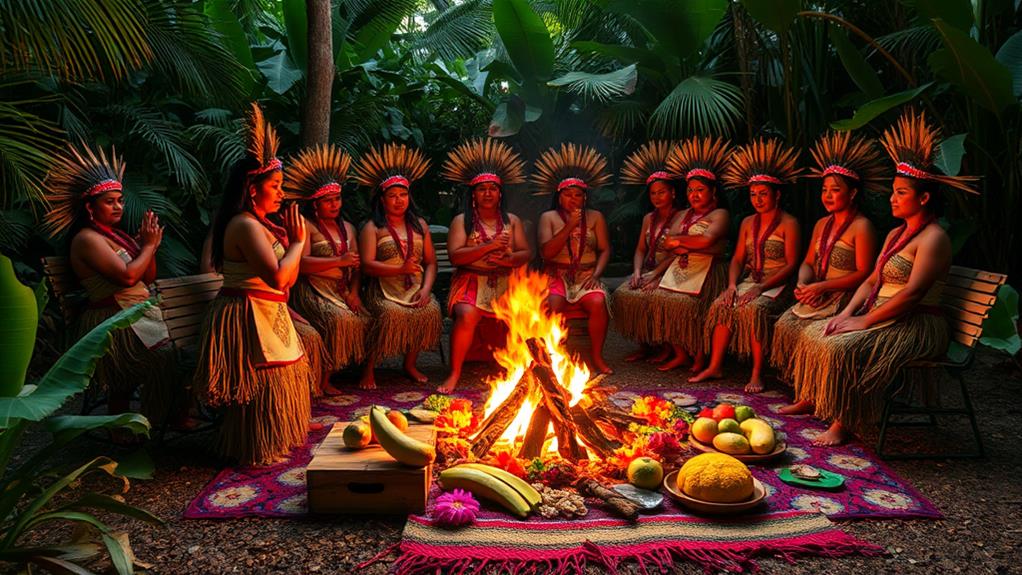
Indigenous Filipino beliefs are rooted in animism, where spirits are believed to inhabit all aspects of life. This worldview is centered around the concept of anito, which encompasses ancestor spirits, nature deities, and supernatural beings. This understanding reflects a deep connection to the spirit world, where every entity, from trees to animals, is believed to possess a soul.
Rituals are essential in indigenous Filipino beliefs, often involving offerings and sacrifices to honor or appease spirits.
Communal feasting is a vital practice, where reverence and celebration come together, allowing communities to bond over shared beliefs. For example, in the Bagobo tradition, souls are categorized into left-hand (evil) and right-hand (good) spirits, highlighting the duality of spiritual existence. This classification emphasizes the importance of respect towards ancestral spirits, guiding individuals in their daily lives and interactions with the spirit world.
Understanding indigenous Filipino beliefs provides a glimpse into a rich cultural identity, which continues to thrive amidst modernization.
Concept of the Soul
In many Filipino cultures, the concept of the soul is deeply intertwined with the understanding of existence and the afterlife. This concept is rooted in indigenous beliefs, which reveal that both humans and animals possess souls that exist beyond physical life as anito, or spirits.
The Bagobo tradition illustrates a dualistic perspective on the soul. In this tradition, left-hand souls are seen as malevolent and right-hand souls as benevolent.
Different ethnic groups have varying beliefs about the number of souls an individual can have. For example, the Tagbanwa propose that individuals may have multiple souls, while the Ifugao culture recognizes two distinct souls per person.
Ancestral spirits hold a significant place in indigenous Filipino cultures. They're revered as protectors and guides for the living, and disrespect towards them is thought to invite harm.
This emphasizes the importance of rituals that honor these spirits.
The transformative journey of the soul fosters a profound reverence for ancestral spirits. As they're seen as integral to the community's spiritual well-being, this interconnectedness reflects how indigenous Filipino cultures navigate the complexities of life, death, and the unseen forces that shape existence.
Core Ritual Practices
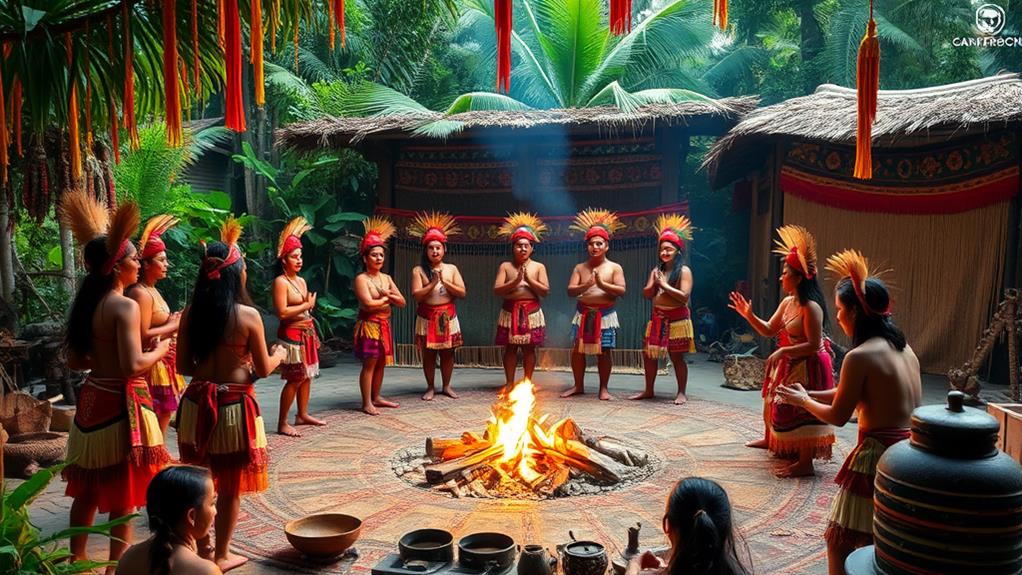
Core Ritual Practices in Filipino Cultures
Core ritual practices in Filipino cultures maintain the spiritual balance between the living and the spirit world. These rituals involve offerings to Anito, including food, animal sacrifices, and valuable items, to appease ancestor spirits and deities. Led by shamans, Pag-anito rituals facilitate communication with these spirits for guidance and protection.
Types of Rituals and Their Purposes
Offerings: Nourish and appease Anito. Key elements: food, sacrifices.
Bloodletting (Padugo): Purify before events. Key element: cleansing the land.
Communal Feasting: Strengthen community bonds. Key elements: shared meals, drinks.
These core practices often conclude with communal feasting, which promotes social cohesion and addresses fears of malevolent spirits through celebratory actions.
The veneration of natural elements at sacred sites, like balete trees and mountains, reveals a profound spiritual connection to the environment. By engaging in these rituals, individuals participate in a tradition that honors the past while ensuring harmony with the unseen forces that shape daily life.
Significance of Anito
Anito: The Bridge Between the Living and the Spiritual Realm
In Filipino indigenous religions, anito hold a vital place, embodying the connection between the living and the spiritual realm. These supernatural beings, which include ancestor spirits and nature deities, deeply influence daily life and rituals, reflecting a rich spiritual hierarchy.
Continuity of Existence
Anito represent continuity of existence beyond physical life, emphasizing the idea that life doesn't end with death. This concept is reflected in the reverence for ancestors, who are believed to continue playing a role in the lives of their descendants.
Ancestor Worship
Ancestor worship in Filipino indigenous religions emphasizes practical intercession over mere filial piety. This means that the living seek the guidance and protection of their ancestors, rather than simply showing respect for them.
Types of Anito
There are different levels of anito, including deities, spirits, and souls of the deceased. Each type of anito has a distinct role and influence on the lives of the living.
Rituals and Respect
Proper rituals and respect for anito are crucial to maintain harmony. The living must show reverence for these supernatural beings through rituals and offerings, lest they face negative consequences.
Guiding the Living
The anito aren't just entities to be revered but active participants in the lives of the living. They guide individuals through ceremonies, ensuring protection and wisdom.
The rituals surrounding anito serve as a bridge, facilitating communication and reinforcing connections between generations.
Deities and Spirits
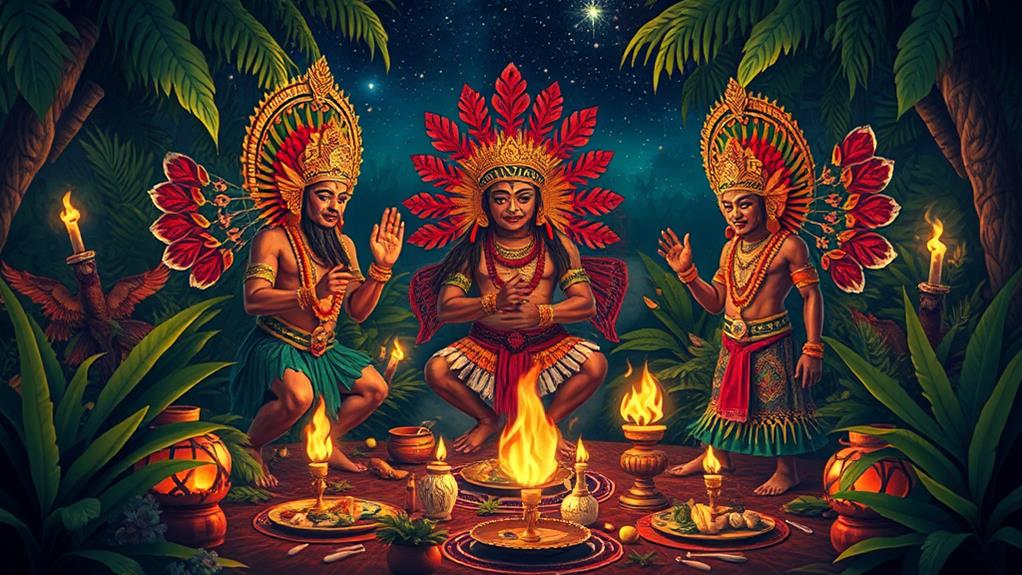
Indigenous Filipino Religions Feature a Diverse Hierarchy of Deities and Spirits
The spiritual landscape of indigenous Filipino religions is shaped by a complex web of beliefs, with each ethnic group having its unique pantheon of deities and spirits. The Tagalogs, for example, revere Bathala as their supreme god, while the Visayans honor Laon. This diversity reflects the different cultural interpretations of the Filipino people.
Anito Plays a Central Role in Rituals
Anito, which encompasses both ancestor spirits and nature deities, occupies a central role in indigenous Filipino rituals. These spirits are believed to impact both physical and spiritual life, guiding community welfare and agricultural success.
They're thought to influence daily existence, from harvests to community relationships.
Lesser Gods and Local Mythology
Lesser gods, often deified ancestors or tribal heroes, enrich the spiritual hierarchy. They emphasize the importance of lineage and local mythology within community rituals.
The presence of local gods, such as Pamulak Manobo and Tigyama, highlights the interconnectedness of spirituality and daily existence.
Understanding Deities and Spirits Reveals Community Significance
Understanding these deities and spirits not only deepens one's appreciation of indigenous Filipino religions but also reveals the profound relationship between spirituality and community life.
Role of Shamans
Shamans: Intermediaries between Physical and Spirit Worlds
In indigenous Filipino cultures, shamans embody the spiritual essence, serving as vital links between the physical and spirit worlds. These spiritual leaders, often women or effeminate men, play a crucial role in community health through their versatile practices.
Healing and Countering Witchcraft
Shamans utilize specific rituals and tools, like talismans, to heal physical and spiritual ailments and counteract witchcraft or supernatural disturbances. They engage in profound connections with ancestor spirits, facilitating communication and guidance for the living.
Leading Rituals and Connecting Communities
In their ceremonies, shamans lead rituals that connect communities to their ancestors, invoking spirits during events like Pag-anito. This highlights their centrality in spiritual practices, as seen in the role of the babaylan, a specialized type of shaman.
Key Aspects of Shamans' Roles
Shamans' roles include:
- Healing physical and spiritual ailments
- Leading rituals that connect communities to their ancestors
- Challenging negative perceptions of witchcraft
- Utilizing tools and rituals to divine the supernatural
- Maintaining the community's overall welfare
Reinforcing Cultural Identity and Community Health
Through these practices, shamans not only address immediate concerns but also reinforce cultural identity, making them indispensable figures in indigenous Filipino religions.
Their unique position allows them to navigate complex spiritual landscapes, ensuring the continuity of traditions and the health of their communities.
Community Ceremonies
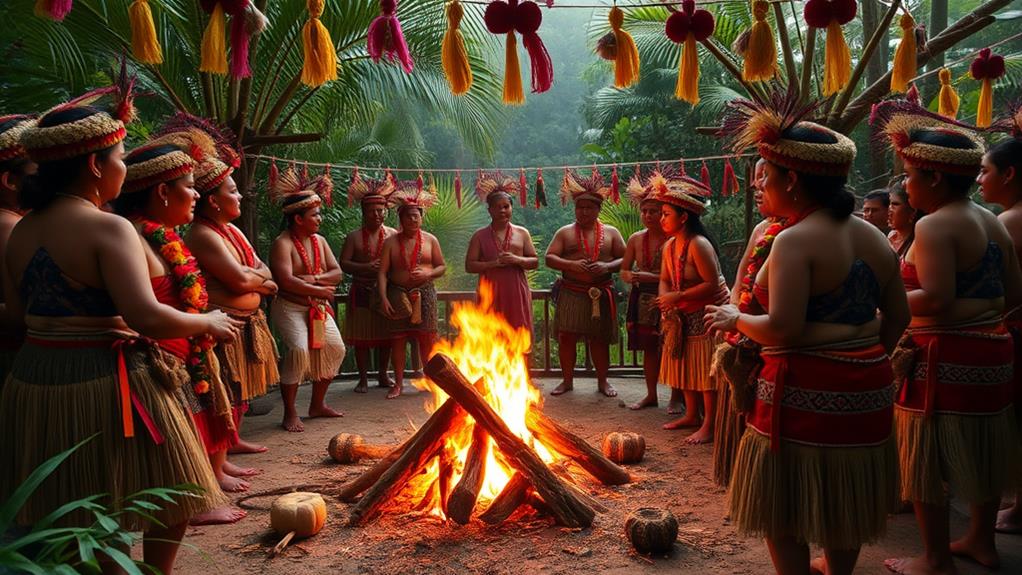
Community Ceremonies in Indigenous Filipino Religions
Unity and Collective Effort
Community ceremonies in indigenous Filipino religions bring together members of the barangay in a shared quest for agricultural success and overall well-being. These ceremonies promote unity and collective effort, essential for strengthening community bonds.
Local leaders or wealthy chiefs often lead these elaborate events, fostering a sense of belonging and shared responsibility among participants.
Honoring Local Gods
At the heart of these ceremonies lies the appeasement of local gods, such as Pamulak Manobo and Tigyama, believed to influence the community's prosperity. Rituals are meticulously crafted to honor these divine beings, integrating spirituality into the community's daily life.
The participation of the entire barangay is crucial, as it reinforces the community's connection to the divine and the land.
Feasting and Communal Celebrations
As rituals conclude, feasting and communal celebrations emerge, balancing reverence for the spirits with joy and togetherness. Myths and local inventions serve to deepen the understanding of these divine beings, enriching the spiritual landscape.
These ceremonies reflect the people's hopes and aspirations, highlighting their connection to the divine and the land.
Maintaining Harmony
Through community ceremonies, the importance of maintaining harmony between the community and their spiritual beliefs is underscored. This harmony ensures agricultural success and wellness for all.
What role do superstitions and beliefs play in the rituals and ceremonies of Indigenous Filipino religions?
Superstitions in filipino folklore are deeply intertwined with the rituals and ceremonies of Indigenous Filipino religions. These beliefs shape the way indigenous communities approach important events, like harvests or births, and influence their daily lives. Superstitions and beliefs provide structure, meaning, and connection to the natural and spiritual worlds.
Festivals and Celebrations
Festivals in the Philippines are vibrant expressions of local culture and heritage, blending indigenous spiritual practices with Catholic influences shaped by historical colonization. These celebrations are essential for community bonding and the reinforcement of cultural identity. Each festival carries unique local significance, often marked by rituals that honor both patron saints and local deities.
Indigenous beliefs are woven into the fabric of modern celebrations, such as the Ati-Atihan festival, which honors a patron saint while showcasing the evolution of indigenous beliefs in a contemporary context. This fusion is evident in the festival's rituals and offerings, which connect participants to their spiritual practices. For instance, the Ati-Atihan festival features dances, songs, and dishes that serve a dual purpose: celebrating the divine and reinforcing cultural heritage.
Festivals foster community bonding, uniting people in shared experiences. The Ati-Atihan festival, for example, brings together locals and tourists alike to celebrate and honor their cultural identity.
They reflect the adaptation of traditions over centuries of colonization, demonstrating the resilience of cultural identity in the face of changing times.
Celebrations highlight the interplay between Catholic influences and local customs. The Ati-Atihan festival is a prime example of this interplay, where indigenous beliefs are woven into Catholic traditions.
Through these festivals, you witness not just the joy of the moment, but also the persistence of spiritual practices and the resilience of cultural identity.
Cultural Heritage and Preservation
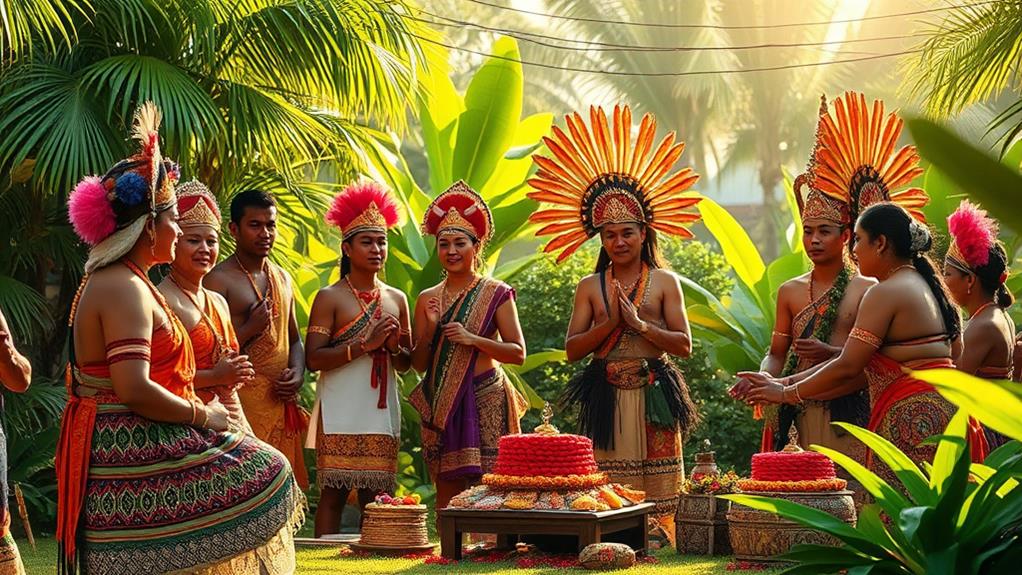
Indigenous Filipino religions are alive and dynamic, evolving within contemporary society. Preservation efforts, such as the NIPAS Law, protect sacred Anitist grounds from degradation, ensuring future generations can connect with their cultural heritage.
For instance, the Ati-Atihan festival showcases this living tradition, blending ancestral beliefs with community celebration, despite the historical impact of Spanish colonization.
Your engagement in cultural heritage preservation is vital. Participating in traditional practices fosters a deep understanding of spiritual identity. Ongoing initiatives focus on education and awareness, allowing you to contribute to the revitalization of indigenous religions.
By attending community events, you can witness firsthand the resilience of these traditions.
Indigenous elements are integrated into Folk Catholicism and Folk Islam, demonstrating adaptability. Despite the decline of tattoo art, a former symbol of status, communities have maintained their core beliefs.
River- and sea-related symbols persist, anchoring contemporary practices in rich mythologies. These efforts ensure indigenous Filipino religions thrive, highlighting the lasting power of cultural heritage.
Questions and Answers
What Is an Example of Indigenous Rituals in the Philippines?
Indigenous rituals in the Philippines reflect rich cultural traditions.
In the Philippines, diverse indigenous groups have their own unique rituals that showcase their cultural heritage.
Kalinga headbinding, for example, signifies beauty and social status. This ritual involves binding the heads of young girls to shape them into a conical form, which is considered a symbol of beauty and a mark of high social status.
Rice rituals are an essential part of Ifugao culture. These rituals celebrate the harvest and express gratitude for the bounty of the land.
In Lumad communities, ritual dances are performed to express community identity. These dances showcase the community's history, traditions, and values.
Healing ceremonies are an important part of Tagbanua culture. These ceremonies connect spiritual and physical well-being, highlighting the importance of balance and harmony in life.
Other examples of indigenous rituals include Mangyan rice planting, Bontoc wedding rites, and Tausug cultural festivals, which showcase communal ties.
Additionally, Igorot agricultural practices and Cebuano baptism traditions honor family and faith.
What Are the Indigenous Religions of the Philippines?
Indigenous religions in the Philippines revolve around ancestral worship and spirit veneration. These beliefs connect individuals to their cultural heritage and emphasize the importance of honoring ancestors and nature spirits.
Ancestral worship involves ritual offerings during community festivals. For example, agricultural ceremonies and healing practices are common ways to engage with nature spirits.
Death rites reflect a profound respect for ancestors, often incorporating shamanic traditions to guide spirits.
These practices not only honor the past but also foster communal ties. They highlight the importance of maintaining these rich traditions in modern society, emphasizing the significance of cultural heritage and community bonding.
What Are Some Filipino Religious Practices?
Filipino religious practices combine animistic beliefs and ancestral worship. These practices often involve communal gatherings during harvest festivals, where people celebrate nature reverence by making spirit offerings to honor deities. For example, the Igorot people in the Cordillera Mountains hold festivities to thank their gods for the harvest, offering rice, vegetables, and wine.
Healing ceremonies take place in sacred spaces, emphasizing the connection between the physical and spiritual realms. In these ceremonies, shamans or spiritual leaders use traditional music and rituals to communicate with ancestors and deities, seeking healing and guidance for the community.
For instance, the T'boli people in Mindanao use the Dreamweaver's song, a traditional melody played on the hegalong, to summon ancestral spirits and guide the healing process.
These practices reflect the profound respect for the environment and ancestors, which is deeply rooted in Filipino culture. By understanding these practices, we can appreciate the rich cultural heritage of the Filipino people.
What Are Rituals and Ceremonies in Religion?
Rituals and ceremonies are essential components of religious practices, fostering a sense of community and spiritual connection. These events often revolve around ancestral worship, healing practices, and crucial life cycles, such as birth, coming of age, marriage, and death.
Ritual symbols are used to convey deeper meanings, creating connections with nature and the spiritual realm. For instance, in many cultures, the ritual symbol of water is used to represent purification and renewal.
Sacred spaces play a vital role in religious rituals and ceremonies, providing a platform for storytelling traditions to unfold. These spaces enrich the cultural tapestry, allowing participants to connect with their community and the spiritual realm.
Engaging in religious rituals and ceremonies enables individuals to connect with their community and the spiritual realm, fostering a deeper understanding of their faith and cultural heritage.